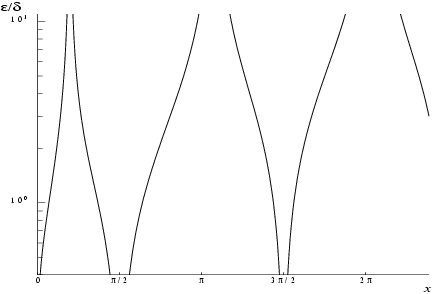s13ac returns the value of the cosine integral
where denotes Euler's constant.
 Syntax
Syntax
| C# |
|---|
public static double s13ac( double x, out int ifail ) |
| Visual Basic |
|---|
Public Shared Function s13ac ( _ x As Double, _ <OutAttribute> ByRef ifail As Integer _ ) As Double |
| Visual C++ |
|---|
public: static double s13ac( double x, [OutAttribute] int% ifail ) |
| F# |
|---|
static member s13ac : x : float * ifail : int byref -> float |
Parameters
- x
- Type: System..::..DoubleOn entry: the argument of the function.Constraint: .
- ifail
- Type: System..::..Int32%On exit: unless the method detects an error or a warning has been flagged (see [Error Indicators and Warnings]).
Return Value
s13ac returns the value of the cosine integral
where denotes Euler's constant.
 Description
Description
s13ac calculates an approximate value for .
For it is based on the Chebyshev expansion
For where the value of is given in the Users' Note for your implementation,
where and ,
.
For , to within the accuracy possible (see [Accuracy]).
 References
References
Abramowitz M and Stegun I A (1972) Handbook of Mathematical Functions (3rd Edition) Dover Publications
 Error Indicators and Warnings
Error Indicators and Warnings
Errors or warnings detected by the method:
- The method has been called with an argument less than or equal to zero for which the function is not defined. The result returned is zero.
 Accuracy
Accuracy
If and are the absolute and relative errors in the result and is the relative error in the argument then in principle these are related by
That is accuracy will be limited by machine precision near the origin and near the zeros of , but near the zeros of only absolute accuracy can be maintained.
The behaviour of this amplification is shown in Figure 1.
For large values of , therefore and since is limited by the finite precision of the machine it becomes impossible to return results which have any relative accuracy. That is, when we have that and hence is not significantly different from zero.
Hence is chosen such that for values of , in principle would have values less than the machine precision and so is essentially zero.
 Parallelism and Performance
Parallelism and Performance
None.
 Further Comments
Further Comments
None.
 Example
Example
This example reads values of the argument from a file, evaluates the function at each value of and prints the results.
Example program (C#): s13ace.cs
